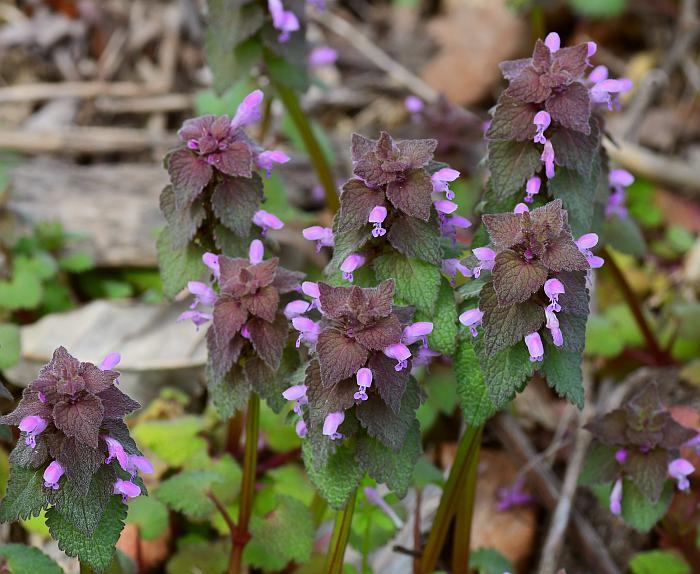Lamium purpureum L.
Dead Nettle

Introduced
CC = *
CW = 5
MOC = 67
© SRTurner
Lamium purpureum L.Dead Nettle | |
 |
Introduced CC = * CW = 5 MOC = 67 |
© SRTurner |
|
Family - Lamiaceae Habit - Taprooted annual forb. Stems - Ascending to erect, to 30 cm, often from a spreading base, hollow, 4-angled, unbranched or more commonly few-to several-branched from below the midpoint, glabrous or more commonly sparsely to moderately pubescent with short, downward-angled hairs, sometimes also with sparse longer, spreading hairs, especially near the nodes.
Leaves - Opposite, decussate, simple. Lower long-petiolate leaves grading upward into short-petiolate leaves (mostly those subtending flower clusters) that are not clasping the stem. Petioles to 3 cm, ciliate. Leaf blades 5-35 mm long, unlobed, the margins with fine to relatively coarse, blunt to sharp teeth, broadly angled to truncate or shallowly cordate at the base, bluntly to sharply pointed or less commonly rounded at the tip, the surfaces moderately to densely pubescent with fine, loosely appressed hairs, those of the lower leaves ovate-triangular to ovate, slightly heart-shaped, or occasionally nearly circular, grading into those of the upper leaves, which are ovate-triangular to broadly ovate, usually longer than wide.
Inflorescence - Dense, typically 3-flowered clusters near the apex of the stems. Bractlets present but inconspicuous and slender. Flowers sessile.
Flowers - Calyces 5-8 mm long, the tube and lobes bristly-hairy, sometimes also with sessile glands, the lobes usually longer than the tube. Corollas zygomorphic, bilabiate, 10-20 mm long (except in cleistogamous flowers), glabrous internally, the outer surface sparsely to densely short-hairy, lacking a differentiated patch of longer, darker hairs on the upper lip, the upper lip 3-6 mm long, rounded to less commonly very shallowly notched at the tip, pale pink to lavender or pinkish purple, the lower lip 1.5-3.0 mm long, usually lighter pink or white, with purple spots or mottling, rarely entirely white, the lateral lobes short (to 0.5 mm), narrowly triangular and toothlike, the central lobe obcordate and sometimes slightly uneven along the margins. Stamens 4, didynamous, fused to the middle of corolla tube. Filaments white, to 6 mm long, glabrous. Anthers brownish, +1mm long, with some white floccose pubescence. Ovary 4-lobed, the lobes truncate at apex, wedge shaped in cross section and trigonous, glabrous, olive-green, 0.5 mm long.
Fruits - Schizocarps, separating into 2-4 nutlets, these 1.5-2.5 mm long, obovoid, truncate at the tip, often with thickened angles, with 2 flat sides and a rounded dorsal face, the surface light brown to grayish brown or olive brown, often with lighter mottling, finely pebbled, glabrous.
Flowering - March-May, occasionally other months. Habitat - Prairies, forest openings, bluffs, streambanks, fields, pastures, barnyards, lawns, roadsides, railroads, open disturbed areas. Origin - Native to Eurasia. Lookalikes - Broadly, L. amplexicaule. Other info. - This is an extremely common weed across most of Missouri, and also in many parts of the continental U.S., particularly in the eastern half of the country. It can form large populations under favorable conditions, typically in disturbed ground. It is easily recognized by general appearance, though from a distance can be hard to distinguish from its sibling, L. amplexicaule. The flowers of these two species are similar but the leaves are very different. Leaves of L. purpureum have a characteristic overlapping, drooping, almost shingle-like aspect and are petiolate, whereas the upper stem leaves of L. amplexicaule are sessile and lend a distinctive pagoda-like appearance to the inflorescences. Photographs taken in Brown Summit, NC., 4-6-03 (DETenaglia); also near Treloar, Warren County, MO, 4-23-2014, along the Katy Trail near Dutzow, Warren County, MO, 4-6-2017, Weldon Spring Conservation Area, St. Charles County, MO, 3-30-2020, and Riverfront Park, Washington, Franklin County, MO, 3-26-2021 (SRTurner). |